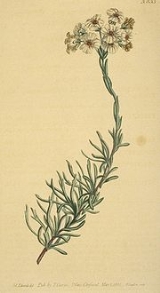
Eriocephalus africanus
Encyclopedia
Also known as the Cape Snow Bush, Eriocephalus africanus is a sweetly-scented, bushy shrub that is indigenous to South Africa
.
Although called by the common name "African rosemary", this bush is not related to the common Mediterranean rosemary
. In South Africa
, E. africanus is a fragrant and medicinal plant having a wide distribution in the Western and Eastern Cape, and in Namaqualand
. E. africanus has silver foliage, with brown and pale yellow inflorescence
s in corymbs. Essential oil derived from E. africanus is used as an ingredient in medicinal and perfume products.
extracts of E. africanus are prepared by steam distillation
, and contain the following primary aroma components:
South Africa
The Republic of South Africa is a country in southern Africa. Located at the southern tip of Africa, it is divided into nine provinces, with of coastline on the Atlantic and Indian oceans...
.
Although called by the common name "African rosemary", this bush is not related to the common Mediterranean rosemary
Rosemary
Rosemary, , is a woody, perennial herb with fragrant, evergreen, needle-like leaves and white, pink, purple or blue flowers, native to the Mediterranean region. It is a member of the mint family Lamiaceae, which includes many other herbs, and is one of two species in the genus Rosmarinus...
. In South Africa
South Africa
The Republic of South Africa is a country in southern Africa. Located at the southern tip of Africa, it is divided into nine provinces, with of coastline on the Atlantic and Indian oceans...
, E. africanus is a fragrant and medicinal plant having a wide distribution in the Western and Eastern Cape, and in Namaqualand
Namaqualand
Namaqualand is an arid region of Namibia and South Africa, extending along the west coast over and covering a total area of 170,000 square miles/440,000 km². It is divided by the lower course of the Orange River into two portions - Little Namaqualand to the south and Great Namaqualand to the...
. E. africanus has silver foliage, with brown and pale yellow inflorescence
Inflorescence
An inflorescence is a group or cluster of flowers arranged on a stem that is composed of a main branch or a complicated arrangement of branches. Strictly, it is the part of the shoot of seed plants where flowers are formed and which is accordingly modified...
s in corymbs. Essential oil derived from E. africanus is used as an ingredient in medicinal and perfume products.
Essential oil
Essential oilEssential oil
An essential oil is a concentrated hydrophobic liquid containing volatile aroma compounds from plants. Essential oils are also known as volatile oils, ethereal oils or aetherolea, or simply as the "oil of" the plant from which they were extracted, such as oil of clove...
extracts of E. africanus are prepared by steam distillation
Distillation
Distillation is a method of separating mixtures based on differences in volatilities of components in a boiling liquid mixture. Distillation is a unit operation, or a physical separation process, and not a chemical reaction....
, and contain the following primary aroma components:
- linalyl acetateLinalyl acetateLinalyl acetate is a naturally occurring phytochemical found in many flowers and spice plants. It is one of the principal components of the essential oils of bergamot and lavender. Chemically, it is the acetate ester of linalool, and the two often occur in conjunction.Synthetic linalyl acetate is...
18.0% - 1,8-cineole 4.3%
- para-cymeneCymeneCymene, or p-cymene, is a naturally occurring aromatic organic compound. It is classified as a hydrocarbon related to a monoterpene. Its structure consists of a benzene ring para-substituted with a methyl group and an isopropyl group...
3.5% - campheneCampheneCamphene is bicyclic monoterpene. It is nearly insoluble in water, but very soluble in common organic solvents. It volatilizes readily at room temperature and has a pungent smell. It is a minor constituent of many essential oils such as turpentine, cypress oil, camphor oil, citronella oil,...
2.8% - linalool 2.5%
- camphorCamphorCamphor is a waxy, white or transparent solid with a strong, aromatic odor. It is a terpenoid with the chemical formula C10H16O. It is found in wood of the camphor laurel , a large evergreen tree found in Asia and also of Dryobalanops aromatica, a giant of the Bornean forests...
2.4% - sabineneSabineneSabinene is a natural bicyclic monoterpene with the molecular formula C10H16. It is isolated from the essential oils of a variety of plants including holm oak and Norway spruce...
2.3% - α-copaeneCopaeneCopaene, or more precisely, α-copaene, is the common chemical name of an oily liquid hydrocarbon that is found in a number of essential oil-producing plants. The name is derived from that of the resin-producing tropical copaiba tree, Copaifera langsdorfii, from which the compound was first...
1.8% - limoneneLimoneneLimonene is a colourless liquid hydrocarbon classified as a cyclic terpene. The more common D isomer possesses a strong smell of oranges. It is used in chemical synthesis as a precursor to carvone and as a renewably-based solvent in cleaning products....
1.1% - geranyl acetate 0.9%
- terpinen-4-olTerpinen-4-olTerpinen-4-ol is a terpene with a molecular weight of 154.249.It is considered the primary active ingredient of tea tree oil. It is also the compound of highest concentration in the essential oil of nutmeg.-Additional images:...
0.9% - α-pinene 0.8%
- valenceneValenceneValencene is a sesquiterpene that is an aroma component of citrus fruit and citrus-derived odorants. It is cheaply obtained from Valencia oranges. Valencene is biosynthesized from FPP by the CVS enzyme....
0.8% - β-pinene 0.7%
- α-terpineolTerpineolTerpineol is a naturally occurring monoterpene alcohol that has been isolated from a variety of sources such as cajuput oil, pine oil, and petitgrain oil. There are three isomers, alpha-, beta-, and gamma-terpineol, the last two differing only by the location of the double bond...
0.6% - β-caryophyllene 0.5%
- myrcene 0.2%

